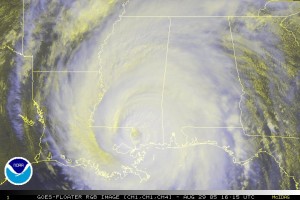
Early in the morning on August 29, 2005, Hurricane Katrina struck the Gulf Coast of the United States. When the storm made landfall, it had a Category 3 rating on the Saffir-Simpson Hurricane Scale–it brought sustained winds of 100–140 miles per hour–and stretched some 400 miles across. The storm itself did a great deal of damage, but its aftermath was catastrophic. Levee breaches led to massive flooding, and many people charged that the federal government was slow to meet the needs of the people affected by the storm. Hundreds of thousands of people in Louisiana, Mississippi and Alabama were displaced from their homes, and experts estimate that Katrina caused more than $100 billion in damage.
Hurricane Katrina: Before the Storm
New Orleans was at particular risk. Though about half the city actually lies above sea level, its average elevation is about six feet below sea level–and it is completely surrounded by water. Over the course of the 20th century, the Army Corps of Engineers had built a system of levees and seawalls to keep the city from flooding. The levees along the Mississippi River were strong and sturdy, but the ones built to hold back Lake Pontchartrain, Lake Borgne and the waterlogged swamps and marshes to the city’s east and west were much less reliable. Even before the storm, officials worried that those levees, jerry-built atop sandy, porous, erodible soil, might not withstand a massive storm surge. Neighborhoods that sat below sea level, many of which housed the city’s poorest and most vulnerable people, were at great risk of flooding.
The day before Katrina hit, New Orleans Mayor Ray Nagin issued the city’s first-ever mandatory evacuation order. He also declared that the Superdome, a stadium located on relatively high ground near downtown, would serve as a “shelter of last resort” for people who could not leave the city. (For example, some 112,000 of New Orleans’ nearly 500,000 people did not have access to a car.) By nightfall, almost 80 percent of the city’s population had evacuated. Some 10,000 had sought shelter in the Superdome, while tens of thousands of others chose to wait out the storm at home.
Click here to read more about Hurricane Katrina.








